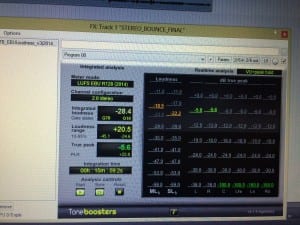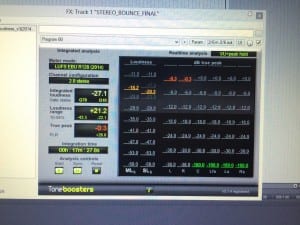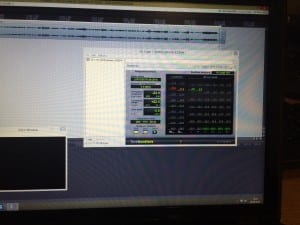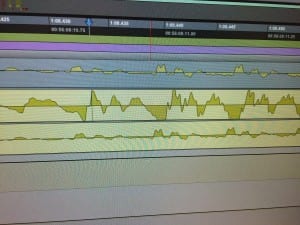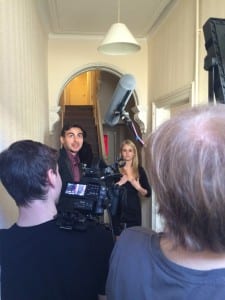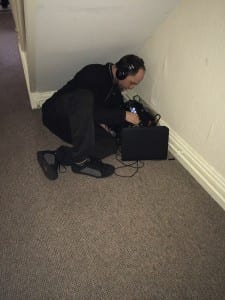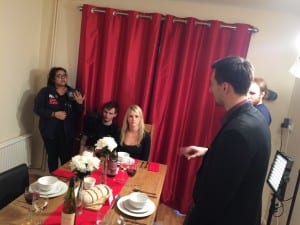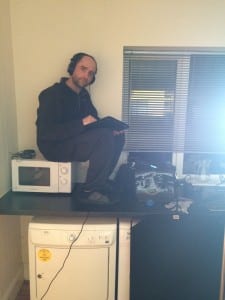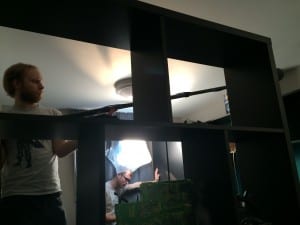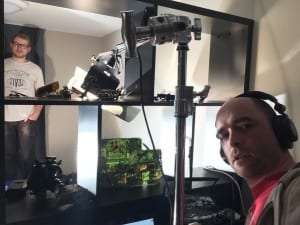(Outcomes – GR1, 2, 3, 4 + IN1 + PER4)
With completion of our final shooting day on Thursday 24th March, production has now wrapped on all of the five films we’re working on, and even with two shoots substantially over-running their initial dates and requiring numerous reshoots we are currently on track for picture-locks for all of the films more or less on time – all of them are scheduled for today, basically. We have also made inroads into some substantial aspects of post production for three of the films over the last few weeks, mainly due to a policy of consistently badgering editors for work in progress cuts of the work which have enabled the members of the team not tied up with location work to make a head start on post-production. The team have also been extremely effectively covering one another for location work, with boom ops and supervisors operating interchangably based on who’s available on any given day. [GR1,2,3]
Amusingly, in terms of our expectations vs the reality of production, the most outwardly-organised group of film-makers with the most ambitious ideas in pre-production have ended up being the most heavily behind schedule, whilst the production team with whom we had a horrendously complex experience last semester that caused their project to overrun by some months (and from whom we half-expected issues this term) ran an extremely efficient shoot which completed without need to recourse to their contingency day and without any significant issues whatsoever. [IN1]
Composition is as good as complete for one picture and underway for two others, with work in progress scratch-tracks having been demoed to the relevant supervisors and the rest of the team for feedback purposes in all those cases. Supervisors have remained in close contact with both directors and editors (in some cases these are the same person) for the films they’re managing, and we are now beginning a process of adapting the initial audio plans for our films to the reality of the pictures as they arrive. [GR1,2]
The sci-fi leaning films are the best examples of this process. Since it is extremely difficult to realise a convincing sci-fi vision with little experience or budget, the two films with sci-fi themes have tended to underplay the futuristic elements visually a little. This leaves more room for the audio to do the work of signifying and world-building, but also requires a deft directorial stance not to allow the audio to undermine the visuals where these haven’t quite matched the director’s initial vision. The picture must always dictate the audio and even if the director’s original vision for a scene was much more interesting from a sound design perspective it’s necessary to rein in the largesse at times. [GR4]
In terms of my own contribution, I’ve been on-set for three of the five films including managing the entire location audio operation and subsequent transfers and admin for Descent, have contributed considerably to sound design and foley aspects of Immort and Feel Good, such as they are completed at the moment. As we’ve got into the momentum of production with the crews, administrative requirements for the project have thankfully slackened off somewhat. [PER4]
My hours spent on the project for March have broken down roughly as follows, not including academic aspects such as blogs or research –
March Total = 101
Admin – 16
Meets – 7
Location – 52
Creative Work – 24.5
Other – 1.5
Our main issue this month has been facilities, as mooted in February’s report. In order to alleviate the pressure on our favoured workspace our institution took the insane decision to cancel 12 of our 38 booked sessions and drastically shorten another 8. This destroyed our post-production schedule at a stroke, and created a veritable storm of admin in planning and rebooking work. We tried to rationalise this into real world terms as if some kind of technical catastrophe had befallen the facility, but practically we have lost any hint of a margin for error on the part of any of the films and experienced another ballooning of administrative time for the project as a consequence. [GR1,2]
The main impact of this complication in terms of the team was morale, since most of us were flat-out on set with little time to think about the ramifications or spend time replanning our post work for the films. As the situation here is now somewhat fluid (it is impossible to say whether the Sound Theatre will actually be available to use for two days of each week until we get to the day), we are setting our work priorities on a week by week basis, with desired outcomes for each film set at the production meeting at the beginning of said week. We’re confident we can manage the films as long as they remain on schedule which, at the present time, largely appears likely.
In the interest of staying ahead of the game the priority for each supervisor going forward is now to decide who will be performing the final mixing of each of their films and where this person will be performing said mix, and then setting a deadline for it’s completion, the latter preferably in confluence with the director of their film. Aside from the benefit of a solid deadline, this will enable a process of centralisation of the data from aspects of audio production for each film which is now being split across multiple people in different environments (our composers are tending to work at home, for example) which will hopefully avoid too many data management and compatibility issues as the aspects of the films come together. [GR1, 2]
——————————————– 950 words
KEY POINTS –
Overview of situation generally for the project and specifically for the film Descent –Professional practice, Process Management.
- [GR1] To professionally operate as a small to medium size company (or other recognisable business entity) in the audio production / post-production field might.
- [GR2] To organise and fulfil an operating strategy and schedule which deals with multiple productions simultaneously, and which maximises efficiency and minimises issues or risks to delivery.
- [IN1] To successfully manage the provision of service by the business for the film Descent with regard the assignment of resources, specialisms and working time, liason with the director, editor and producer on a practical and creative level, and communication of information on their needs and requirements for the piece, in order to appraise the efficacy of the collaborative approach to working on the piece – (Supervisor and Company Officer)
Breakdown of work carried out in March – Contribution
- [GR3] To provide a professional standard of service in respect to location sound recording and post-sound design / mixing.
- [GR4] To conceive, compose, source and / or produce music to client specifications that synergistically supports the other components of their films.
Collective creative process – Process Management
- [GR1] To professionally operate as a small to medium size company (or other recognisable business entity) in the audio production / post-production field might.
- [GR2] To organise and fulfil an operating strategy and schedule which deals with multiple productions simultaneously, and which maximises efficiency and minimises issues or risks to delivery.
Contribution specifics – Contribution
- [PER4] To contribute extensively to multiple film productions.
Reflection on process of adapting audio plans and outcome of facilities issues– Individual reflection on learning and team role
